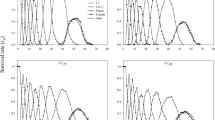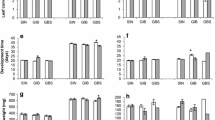Abstract
Effects of 2-β-D-glucopyranosyloxy-4-hydroxy-7-methoxy-1,4benzoxazin-3-one (DIMBOA-Glc) and DIMBOA-Glc N-O-methylated (HDMBOA-Glc), two compounds present in high concentration in maize, were tested on the aphid Metopolophium dirhodum reared on artificial diet. HDMBOA-Glc and DIMBOA-Glc decrease survival of adults with an LD50 of 1 mM and 5.6 mM, respectively, after 72 hr of feeding. These compounds also decrease the fecundity of the aphids at concentrations of 2 mM and 1 mM, respectively. At concentrations of 2 mM HDMBOA-Glc and 8 mM DIMBOA-Glc in the diet, the average lifetime fecundity of 10 females is near zero. Offspring mortality on diet with 2 mM DIMBOA-Glc is significantly higher than with the control diet. In contrast, HDMBOA-Glc has no effect on the survival of offspring. The possibility that these compounds protect Poaceae against aphids is discussed.
Similar content being viewed by others
REFERENCES
ABBOTT, W. S. 1925. A method of computing the effectiveness of an insecticide. J. Econ. Entomol.18:265-267.
ARGANDONA, V. H., and CORCUERA, L. J. 1985. Distribution of hydroxamic acids in Zea maystissues. Phytochemistry24:1-15.
ARGANDONA, V. H., LUZA, J. G., NIEMEYER, H. M., and CORCUERA, L. J. 1980. Role of hydroxamic acids in the resistance of cereals to aphids. Phytochemistry19:1665-1668.
ARGANDONA, V. H., NIEMEYER, H. M., and CORCUERA, L. J. 1981. Effect of content and distribution of hydroxamic acids in wheat on infestation by the aphid Schizaphis graminum. Phytochemistry20(4):673-676.
ARGANDONA, V. H., CORCUERA, L. J., NIEMEYER, H. M., and CAMPBELL, B. C. 1983. Toxicity and feeding deterrency of hydroxamic acids from gramineae in synthetic diets against the greenbug, Schizaphis graminum. Entomol. Exp. Appl.34:134-138.
AUCLAIR, J. L. 1965. Feeding and nutrition of the pea aphid, Acyrthosiphon pisum(Homoptera: Aphidae), on chemically defined diets of various pH and nutrients levels. Ann Entomol. Soc. Am.58(6):855-875.
CAILLAUD, C. M., and NIEMEYER, H. M. 1996. Possible involvement of the phloem sealing system in the acceptance of a plant as host by an aphid. Experientia 52:927-931.
CAMBIER, V., HANCE, T., and DE HOFFMANN, E. 1999. Noninjured maize contain several 1,4-benzoxazin-3-one related compounds but only as glucoconjugates. Phytochem. Anal.10:119-126.
CAMBIER, V., HANCE, T., and DE HOFFMANN, E. 2000. Variation of DIMBOA and related compounds content in relation to the age and plant organ in maize. Phytochemistry53:223-229.
CORCUERA, L. J., QUEIROLO, C. B., and ARGANDONA, V. H. 1985. Effects of 2-ß-D-glucosyl-4-hydroxy-7-methoxy-1,4-benzoxazin-3-one on Schizaphis graminum(Rondani) (Insecta, Aphididae) feeding on artificial diets. Experientia41:514-516.
DREYER, D. L., and CAMPBELL, B. C. 1987. Chemical basis of host-plant resistance to aphids. Plant, Cell Environ.10:353-361.
ESCOBAR, C. A., SICKER, D., and NIEMEYER, H. M. 1999. Evaluation of DIMBOA analogs as antifeedants and antibiotics towards the aphid Sitobion avenaein artificial diet. J. Chem. Ecol.25(7):1543-1554.
FINNEY, D. J. 1971. Probit Analysis. Cambridge University Press.
GIVOVICH, A., and NIEMEYER, H. M. 1995. Comparison of the effect of hydroxamic acids from wheat on five species of cereal aphids. Entomol. Exp. Appl.74:115-119.
GIVOVICH, A., MORSE, S., CERDA, H., NIEMEYER, H. M., WRATTEN, S. D., and EDWARDS, P. J. 1992. Hydroxamic acid glucosides in honeydew of aphids feeding on wheat. J. Chem. Ecol.18(6):841-846.
GIVOVICH, A., SANDSTRöM, J., NIEMEYER, H. M., and PETTERSON, J. 1994. Presence of a hydroxamic acid glucoside in wheat phloem sap, and its consequences for performance of Rhopalosiphum padi(L.) (Homoptera: Aphididae). J. Chem. Ecol.20(8):1923-1930.
HOUSEMAN, J. G., CAMPOS, F., THIE, N. M. R., PHILOGÈ NE, B. J. R., ATKINSON, J., MORAND, P., and ARNASON, J. T. 1992. Effect of the maize-derived compounds DIMBOA and MBOA on growth and digestive processes of european corn borer (Lepidoptera: Pyralidae). J. Econ. Entomol.85(3):669-674.
KENNEDY, J., and HANCE, T. 1995. Varietal screening based on demographic parameters: resistance of tea to Brevipalpus phoenicis(Acari: Tenuipalpidae). Environ. Entomol.24(6):1481-1486.
LONG, B. J., DUNN, G. M., BOWMAN, J. S., and ROUTLEY, D. G. 1977. Relationship of hydroxamic acid content in corn and resistance to the corn leaf aphid. Crop Sci.17.
MASSARDO, F., ZUNIGA, G. E., PEREZ, F. J., and CORCUERA, L. J. 1994. Effects of hydroxamic acids on electron transport and their cellular location in corn. Phytochemistry35:873-876.
MAYORAL, A. M., TJALLINGII, W. F., and CASTANERA, P. 1996. Probing behaviour of Diuraphis noxiaon five cereal species with different hydroxamic acid levels. Entomol. Exp. Appl.78:341-348.
MOLYNEUX, R. J., CAMPBELL, B. C., and DREYER, D. L. 1990. Honeydew analysis for detecting phloem transport of plant natural products. J. Chem. Ecol.16(6):1899-1909.
SAS. 1985. SAS user's Guide: Statistics, Version 5 ed. Cary, North Carolina.
THACKRAY, D. J., WRATTEN, S. D., EDWARDS, P. J., and NIEMEYER, H. M. 1990. Resistance to the aphids Sitobion avenaeand Rhopalosiphum padiin Gramineae in relation to hydroxamic acid levels. Ann. Appl. Biol.116:573-582.
VAN IMPE, G., and HANCE, T. 1993. Une technique d'évaluation de la sensibilité variétale au Tétranyque tisserand, Tetranychus urticaeKoch (Acari: Tetranychidae). Application au haricot, au concombre, à la tomate et au fraisier. Agronomie 13:739-749.
WAHLROOS, O., and VIRTANEN, I. 1959. The precursors of 6-methoxy-benzoxazolinone in maize and wheat plants, their isolation and some of their properties. Acta Chem. Scand.13(9):1906-1908.
XIE, Y. S., ARNASON, J. T., PHILOGÈ NE, B. J. R., and LAMBERT, J. D. H. 1990. Role of 2,4-dihydroxy-7-methoxy-1,4-benzoxazin-3-one (DIMBOA) in the resistance of maize to western corn rootworm, Diabrotica virgifera virgifera(Leconte) (Coleoptera: Chrysomelidae). Can. Entomol.122:1177-1186.
Author information
Authors and Affiliations
Rights and permissions
About this article
Cite this article
Cambier, V., Hance, T. & De Hoffmann, E. Effects of 1,4-Benzoxazin-3-One Derivatives from Maize on Survival and Fecundity of Metopolophium dirhodum (Walker) on Artificial Diet. J Chem Ecol 27, 359–370 (2001). https://doi.org/10.1023/A:1005636607138
Issue Date:
DOI: https://doi.org/10.1023/A:1005636607138




